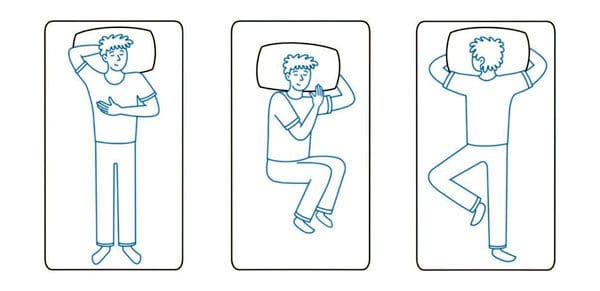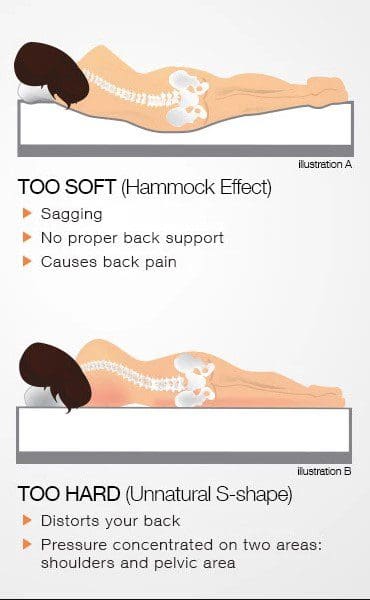Achieving Better Sleep With Chronic Back Pain
- Bones
- Joints
- Ligaments
- Muscles
- Injured
- Strained
- Sprained

Achieving Sleep Solutions
The connection between sleep disturbance in individuals who suffer from acute or chronic back pain is high. Fortunately, back pain does not have to ruin the sleep experience. There are strategies to achieve better sleep. These include:- Adjusting sleep positions
- Improving sleep hygiene
- Better understanding the source of pain
Sleep Positions
When back pain presents, finding a comfortable position leads to endless tossing and turning. But sleeping in the wrong position can worsen chronic/acute back pain, or create new injury and pain. Here are some options for alleviating pain:
Back sleeping
Sleeping on the back is the best position anatomically, especially for back pain. It evenly distributes the body’s weight putting less strain on the back. For optimal results, use a soft pillow with minimal height to keep the spine aligned with the neck through the low back. Placing a pillow under the legs can also reduce stress on the low back. Back sleeping is also not recommended for pregnant women in their second or third trimester. This is because the weight can press against the spine causing strain. It can also press on the main vein that carries blood back to the heart from the lower extremities. This can interfere with circulation causing dizziness. For this stage sleeping on the side is recommended.Side sleeping
Sleeping on the side is considered a safe position for those with back pain. However, this is only if the mattress has proper support. Side sleepers need a mattress that maintains spinal alignment. Any strain while sleeping translates into backaches. Side sleepers should also utilize a pillow with enough height to hold their heads so that the spine stays aligned. To keep the mid-spine from sinking into the mattress, place a pillow in the waist area below the ribcage above the pelvis. This will maintain a neutral position. Using a pillow between the legs and slightly with the knees up toward the torso in a relaxed position along with a body pillow for extra comfort and support.Stomach sleeping
Stomach sleeping is strongly discouraged by a majority of medical professionals, including the American Chiropractic Association. This is because this flattens the natural curve of the spine, straining the low back placing unnecessary pressure on the neck from twisting the head for prolonged periods. If stomach sleeping is a must use a pillow with a very little height so that the neck stays aligned with the backbone. Also, place a thin pillow under the pelvis, this gives the lower back more support.
Achieving Pain-Free Sleep
Here are some other strategies for achieving pain-free sleep.Mattress quality
Mattress quality affects healthy sleep, especially when it comes to back pain. Older, sagging mattresses lose performance factors needed to support the lower back, relieve pressure points, and maintain spinal alignment. Newer mattresses with memory foam, latex, or a hybrid with a core of innerspring, have been proven to help back pain and achieve better sleep.Getting in and out of bed
Getting into and out of bed can be a challenge. There are techniques that limit movement and put minimal pressure on the back, reducing back pain. One technique works by sitting on the edge of the bed and then leaning to the right or left making sure to keep the spine aligned and ease down onto the mattress. Bring the knees up so the body is entirely on its side. Then, in one smooth movement, gently roll onto the back. To get out of bed do the same steps reversed. Because getting into and out of bed requires sitting or lying on the edge of the mattress, make sure the mattress has enough edge support so it won’t sag when sitting.Healthy sleep habits
Adopting healthy sleep habits ensures proper sleep. Establish a consistent sleep schedule going to bed and waking up at around the same time every day, including weekends. Schedule at least 7-9 hours of sleep every night. Establish a relaxing nighttime routine around half an hour to an hour before sleep to help release any tension.- Take a warm bath
- Practice yoga or meditation
- Listen to gentle music
- Read a little
- Avoid electronic devices
- Don’t drink caffeinated drinks from mid-afternoon on
- Drink warm caffeine-free tea to help the body calm down before sleep
- Sleep in an environment that is cool, dark, and comfortable

Back Pain Types
Pain can be severe or persistent. Understanding the source is one of the first steps toward knowing how to treat and manage it.Posture
The bones and muscles can slip out of alignment with poor posture and not switching positions to allow the muscles, and bones to relax and recover. This can lead to:- Muscle tightness
- Headaches
- Back pain upper to lower
- Muscle fatigue
- Tingling
- Numbness
Muscle Strain
Muscle strains happen when the muscles or attaching tendons get damaged. This can happen when lifting something heavy or working out too hard. However, it can also happen during regular activities if the muscles are not warmed up. Muscle strain can cause swelling, bruising/redness, and pain in the muscle/s even when resting.Nerve Pain
Nerve pain can is unpredictable. Nerve-related back pain usually involves the sciatic nerve. When the sciatic nerve becomes irritated, inflamed, pinched, or compressed, the pain can be felt in the low back and radiate down the leg to the foot.Fractures and Bone Spurs
Bone pain is usually caused by a fracture or bone spur. Fractures cause a deep ache. Bone spurs, or bony growths that appear on the edge of a bone, often along the spine. If bone spurs press on the nerves, it can cause:- Weakness
- Numbness
- Tingling in the arms or legs
- Muscle spasms and cramps
Medical Emergency
Sometimes back pain requires a visit to a medical professional to rule out more serious causes, like fractures, tumors, or infections of the spine. Symptoms to look out for include:- Fever could indicate an infection
- Trauma, like a fall, could indicate a fracture
- A diagnosis of osteoporosis could mean a fracture has occurred
- Numbness or tingling could indicate nerve irritation/inflammation damage
- History of cancer
- Foot drop condition and needing to lift the foot higher to prevent dragging, which could be a sign of a nerve or a muscle condition
- Pain that presents only at night when sleeping
- Unexplained weight loss can accompany infection or tumors
- Advanced age increases the risk for infections, tumors, and abdominal issues
Better Sleep
Around 80% of the world’s population will experience backache, and back pain at some point. When the spine’s bones, joints, ligaments, and muscles become injured, strained, or sprained, it can interfere with sleep. Try some of these strategies to help reduce the pain so sleeping well and waking up refreshed can be achieved.Body Composition
Increase Movement with Exercise
One reason the body could be holding on to extra weight could be from high cortisol levels. Cortisol increases when stressed. Stress can derail exercise routine, diet, and sleep, increasing the chances of becoming overweight/obese. With exercise, the body releases endorphins or hormones that help reduce pain and stress. Exercise does not mean intense gym workouts. It can be as simple as taking small parts of the day, moving around to get the blood flowing, and muscles, tendons, ligaments stretched out. For example, if an individual uses the elevator or escalator regularly, take the stairs instead. Or take a short walk. All it takes is small and consistent adjustments to achieve health.Dr. Alex Jimenez’s Blog Post Disclaimer
The scope of our information is limited to chiropractic, musculoskeletal, physical medicines, wellness, and sensitive health issues and/or functional medicine articles, topics, and discussions. We use functional health & wellness protocols to treat and support care for injuries or disorders of the musculoskeletal system. Our posts, topics, subjects, and insights cover clinical matters, issues, and topics that relate and support directly or indirectly our clinical scope of practice.* Our office has made a reasonable attempt to provide supportive citations and has identified the relevant research study or studies supporting our posts. We also make copies of supporting research studies available to the board and or the public upon request. We understand that we cover matters that require an additional explanation as to how it may assist in a particular care plan or treatment protocol; therefore, to further discuss the subject matter above, please feel free to ask Dr. Alex Jimenez or contact us at 915-850-0900. The provider(s) Licensed in Texas& New Mexico*References
Cochrane Database of Systematic Reviews. (2010.) “Advice to rest in bed versus advice to stay active for acute low-back pain and sciatica.â€Â pubmed.ncbi.nlm.nih.gov/20556780/ National Library of Medicine. MedlinePlus. (Updated April 30, 2020.) “Back Pain.â€Â medlineplus.gov/backpain.htmlPost Disclaimers
Professional Scope of Practice *
The information herein on "Achieving Better Sleep With Chronic Back Pain" is not intended to replace a one-on-one relationship with a qualified health care professional or licensed physician and is not medical advice. We encourage you to make healthcare decisions based on your research and partnership with a qualified healthcare professional.
Blog Information & Scope Discussions
Our information scope is limited to Chiropractic, musculoskeletal, physical medicines, wellness, contributing etiological viscerosomatic disturbances within clinical presentations, associated somatovisceral reflex clinical dynamics, subluxation complexes, sensitive health issues, and/or functional medicine articles, topics, and discussions.
We provide and present clinical collaboration with specialists from various disciplines. Each specialist is governed by their professional scope of practice and their jurisdiction of licensure. We use functional health & wellness protocols to treat and support care for the injuries or disorders of the musculoskeletal system.
Our videos, posts, topics, subjects, and insights cover clinical matters, issues, and topics that relate to and directly or indirectly support our clinical scope of practice.*
Our office has reasonably attempted to provide supportive citations and has identified the relevant research study or studies supporting our posts. We provide copies of supporting research studies available to regulatory boards and the public upon request.
We understand that we cover matters that require an additional explanation of how it may assist in a particular care plan or treatment protocol; therefore, to further discuss the subject matter above, please feel free to ask Dr. Alex Jimenez, DC, or contact us at 915-850-0900.
We are here to help you and your family.
Blessings
Dr. Alex Jimenez DC, MSACP, RN*, CCST, IFMCP*, CIFM*, ATN*
email: coach@elpasofunctionalmedicine.com
Licensed as a Doctor of Chiropractic (DC) in Texas & New Mexico*
Texas DC License # TX5807, New Mexico DC License # NM-DC2182
Licensed as a Registered Nurse (RN*) in Florida
Florida License RN License # RN9617241 (Control No. 3558029)
Compact Status: Multi-State License: Authorized to Practice in 40 States*
Presently Matriculated: ICHS: MSN* FNP (Family Nurse Practitioner Program)
Dr. Alex Jimenez DC, MSACP, RN* CIFM*, IFMCP*, ATN*, CCST
My Digital Business Card






 Again, I Welcome You.
Again, I Welcome You.
Comments are closed.